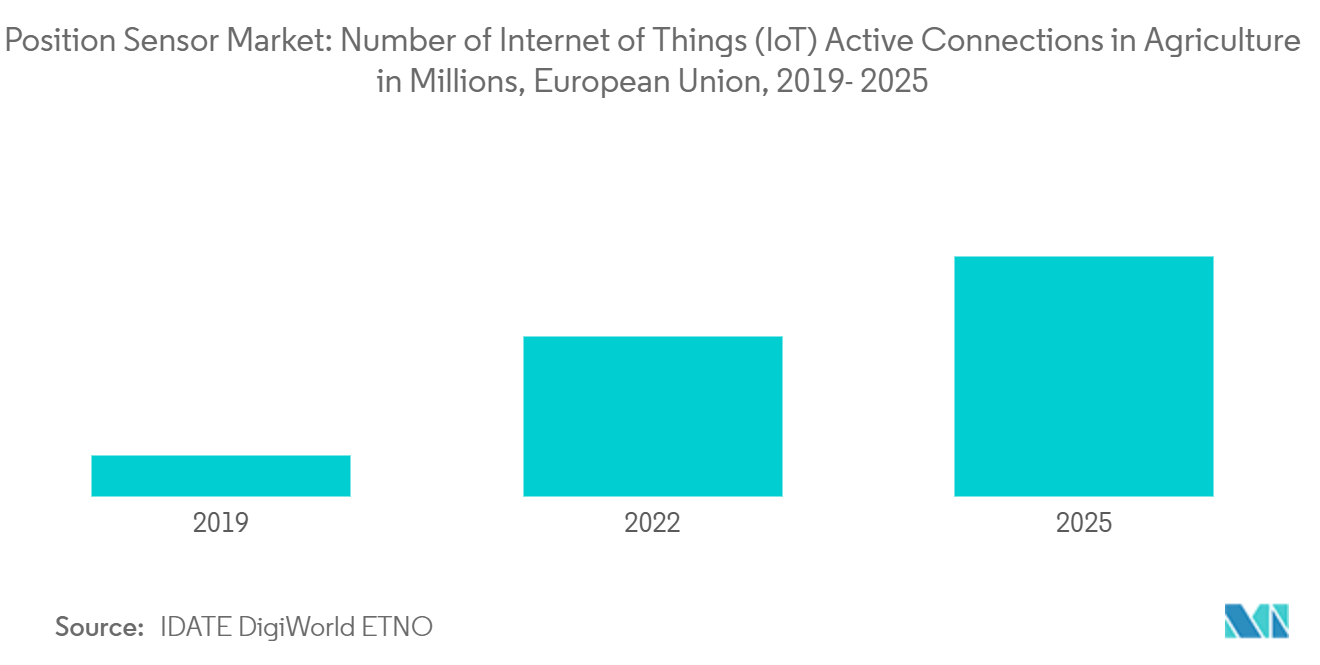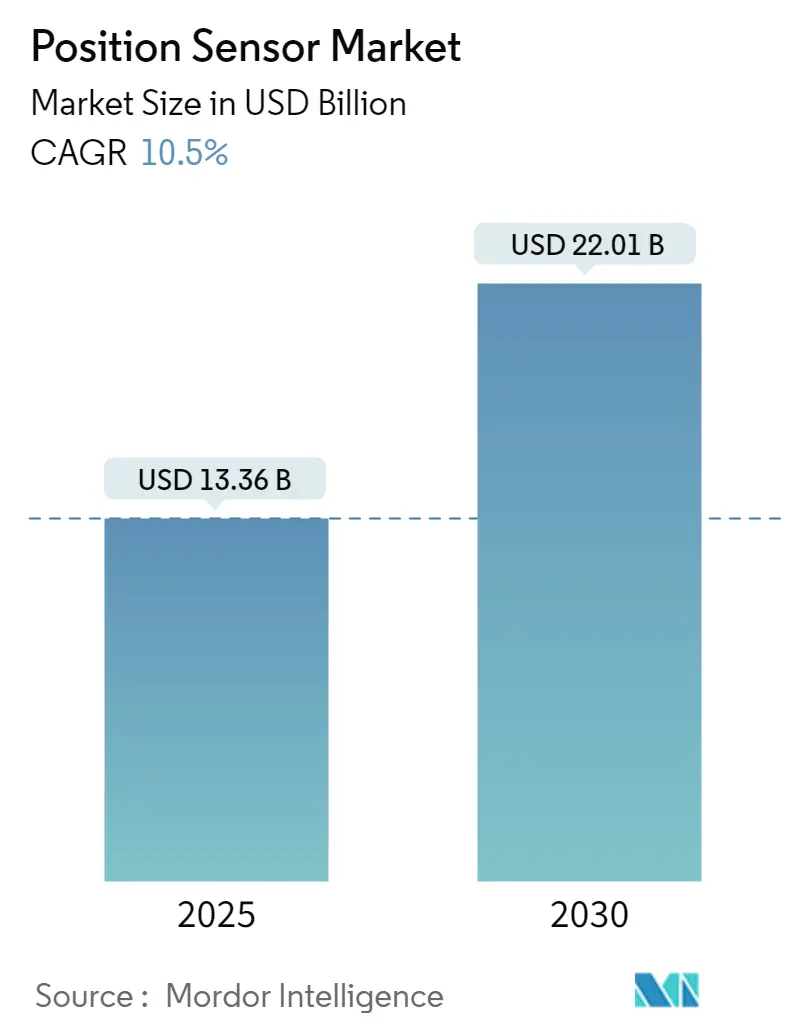
| Study Period | 2019 - 2030 |
| Market Size (2025) | USD 13.36 Billion |
| Market Size (2030) | USD 22.01 Billion |
| CAGR (2025 - 2030) | 10.50 % |
| Fastest Growing Market | Asia Pacific |
| Largest Market | North America |
| Market Concentration | High |
Major Players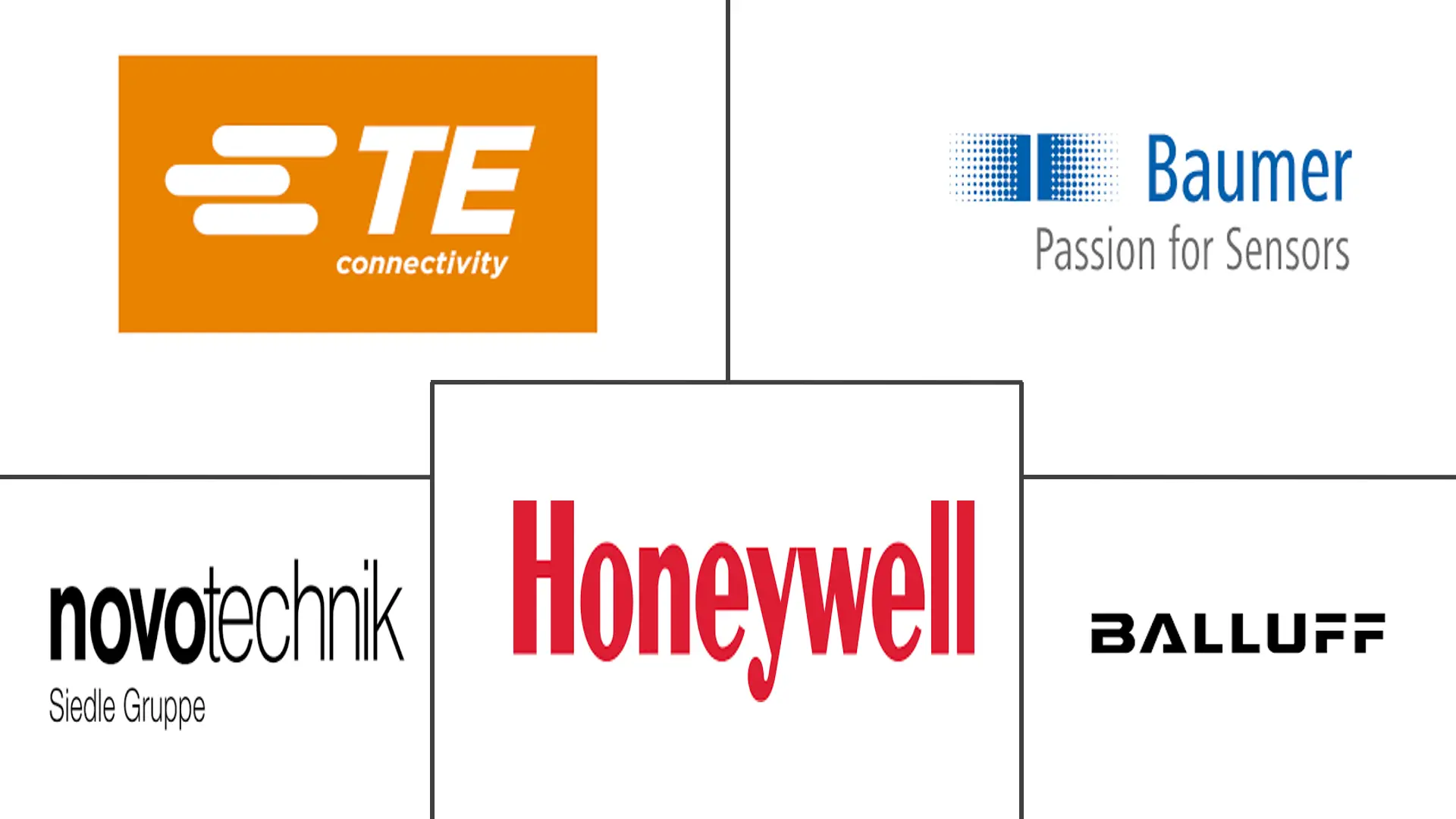
*Disclaimer: Major Players sorted in no particular order |
Position Sensor Market Analysis
The Position Sensor Market size is estimated at USD 13.36 billion in 2025, and is expected to reach USD 22.01 billion by 2030, at a CAGR of 10.5% during the forecast period (2025-2030).
The position sensor market in agriculture has grown significantly as modern farming techniques increasingly adopt smart technologies. This surge is primarily driven by the widespread adoption of precision farming, where position sensors are crucial for GPS-guided equipment, field mapping, and real-time monitoring. Agricultural machinery, including autonomous tractors, drones, and smart irrigation systems dominated the position sensor market. These devices rely on position sensors for accurate navigation, enhancing field operations, and reducing human intervention.
North America dominated the position sensor market, benefiting from the early adoption of precision and large-scale farming practices. For instance, according to the United States Department of Agriculture (USDA), in 2023, 27% of United States farms or ranches used precision agriculture practices to manage crops or livestock. Meanwhile, Europe and Asia-Pacific are catching up due to government initiatives promoting smart farming and increased investments in agricultural innovation. For instance, in 2024, the Indian government plans to invest USD 722.8 million in smart farming using AI, drones, and data to increase crop yields. Additionally, 22 Precision Farming Development Centers (PFDCs) have been established nationwide to test and adapt new technologies to local requirements. The integration of IoT in agriculture has further boosted demand for position sensors, to monitor crop health, soil moisture, and weather conditions. As automation becomes central to farming, the need for precise positioning in machinery and equipment will grow.
However, challenges persist. The high initial cost of installing advanced position sensors, particularly for small and medium-sized farms, remains a barrier to widespread adoption. Additionally, many farmers lack the technical expertise needed to effectively integrate these systems into their operations. Limited internet infrastructure in rural areas also hampers the full potential of sensor-based technologies. Despite these challenges, the future of the position sensor market in agriculture looks promising. Factors such as government incentives, the push for resource optimization, and increasing demand for sustainable farming practices continue to drive the market.
Position Sensor Market Trends
Increased Adoption of Precision Agriculture, and Government Initiatives Driving the Market
- Position sensors play a crucial role in precision agriculture, enabling GPS-based guidance, field mapping, and the automation of farming equipment. By accurately positioning machinery and monitoring field conditions in real time, these sensors help farmers optimize resource use, reduce operational costs, and increase crop yields. According to the Precision Agriculture Policy & Adoption Outlook 2023, the USA is the leading and earliest adopter of precision agriculture. Currently, many large farms in the United States utilize precision technologies, such as variable-rate technology and guidance systems. Canada and 20% of Australia's larger farms are also notable adopters. In Denmark, 80% of wheat and barley farmers, along with 30-40% of oilseed growers, have adopted this technology. Meanwhile, countries such as Argentina, Brazil, Turkey, and South Africa, are starting to incorporate this technology into their farm management practices.
- Government initiatives play a crucial role in this technological transition. In August 2023, Canada's Ministry of Agriculture and Agri-Food announced an investment of up to USD 31,796.0 under the Adoption Stream of the Agricultural Clean Technology (ACT) Program. This funding supports the Francois Delorme farm in acquiring fertilizer spreader equipment with variable rate technology. In 2021, the Australian government allocated USD 66 million to set up eight Innovation Hubs, focusing on enhancing research in digital technologies. This was supplemented by an additional USD 114 million in 2022 to further bolster these hubs. These hubs aim to connect researchers, investors, technology developers, and producers, fostering innovation. Similarly, India's National Mission for Sustainable Agriculture (NMSA) promotes precision farming by subsidizing GPS-enabled equipment, significantly enhancing resource efficiency and productivity for Indian farmers.
- Recent advancements in sensor technology, particularly in GNSS and sensor fusion, have made these systems both more accurate and cost-effective. For instance, John Deere's high-precision GPS systems, featuring cutting-edge position sensors, can enhance crop yields by 10% and cut input costs by 15%. Moreover, ongoing technological innovations in agriculture are poised to further boost the market's growth. According to ETNO, IoT connections in agriculture are on the rise in the European Union. From 46.92 million connections in 2022, the number is projected to climb to 70.26 million by 2025. IoT devices in agriculture find applications like drone surveillance. Such technological advancement, bolstered by government support, are accelerating the shift towards precision agriculture and fueling the growth of the position sensor market in the agricultural sector.
North America Dominates Position Sensor Market
- North America dominates the position sensor market, particularly in agriculture. The United States is the largest market in the region. According to a 2023 Economic Research Services (USDA) report, up to 27% of large-holding farms have adopted precision agriculture technologies, including position sensors. However, among small farms, which constitute over 85% of United States farms, adoption rates remain low. The United States leads in position sensor adoption, largely due to government initiatives promoting precision agriculture. From fiscal years 2017 to 2021, the United States Department of Agriculture (USDA) and National Science Foundation (NSF) provided USD 98.9 million and USD 93.2 million, respectively, for precision agriculture R&D. USDA funding is primarily channeled through its Agricultural Research Service (ARS), Economic Research Service (ERS), and National Institute of Food and Agriculture (NIFA). NSF also provides grants to advance precision agriculture research.
- USDA reports that adopting precision technology in corn cultivation can increase net returns by USD 3.73 per acre, on top of the average USD 85.0 per acre earned by United States corn farmers. Similarily, a Goldman Sachs study revealed that overall sensor prices decreased by 50% in the last decade, creating significant growth opportunities for precision agriculture. This trend towards automation is projected to drive the adoption of precision agriculture in the country, consequently boosting the position sensor market.
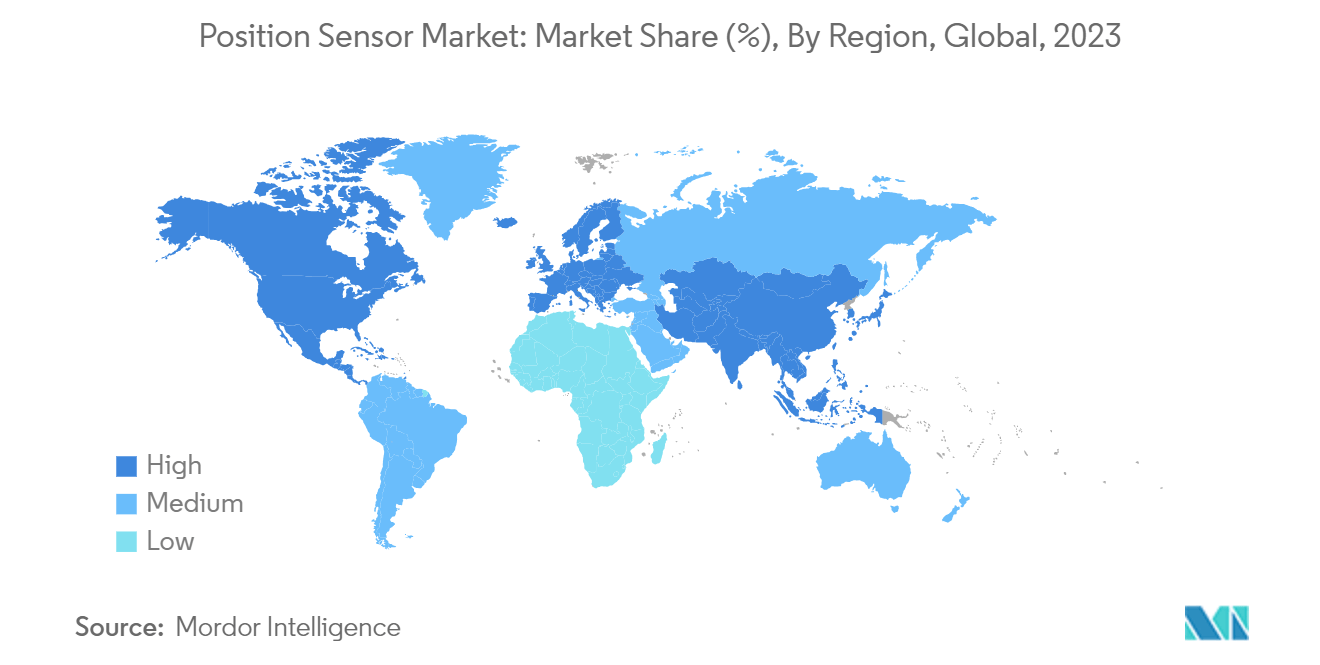
Position Sensor Industry Overview
The market is consolidated due to the presence of a few prominent players, accounting for more than half of the total market share. The key players in the market include Honeywell International Inc., TE Connectivity, Balluff Inc., Baumer, Novotechnik, and Sensor Solutions Corp. Extensive R&D activities and subsequent product innovations were the strategies most adopted by the companies to gain a stronger foothold in the market globally.
Position Sensor Market Leaders
-
Honeywell International Inc.
-
TE Connectivity
-
Balluff Inc
-
Baumer
-
Novotechnik
- *Disclaimer: Major Players sorted in no particular order
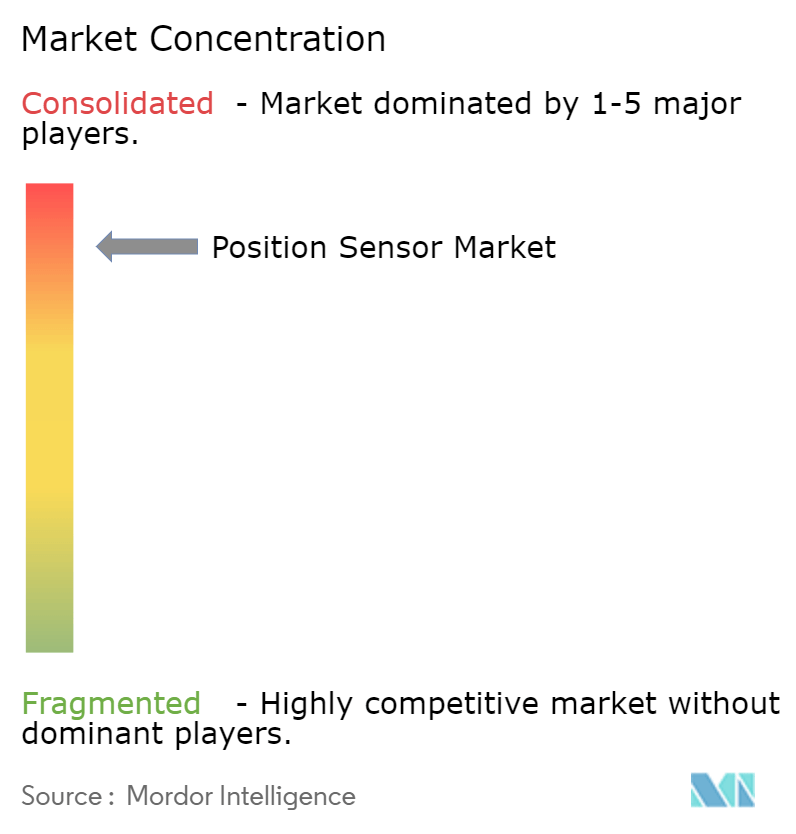
Position Sensor Market News
- April 2024: TE Connectivity (TE) announced the expansion of its IoT (Internet of Things) wireless pressure sensor offerings. In response to the growing demand for advanced data acquisition for precise condition monitoring, TE introduced two new wireless pressure sensors to its portfolio: the 65xxN wireless pressure sensor for short-range coverage and the 69xxN wireless pressure sensor for long-range coverage.
- March 2022: Baumer added two new photoelectric sensors, OT300 and OT500, into its portfolio that can combine a large detection range with reliable object detection even on challenging surfaces.
- September 2021: Balluff Inc. launched BOS R81K series sensors designed for area-wide use. It can be used in confined installation situations due to its design, mostly in conveyor belts.
Position Sensor Industry Segmentation
Position sensors enable farmers to monitor and optimize crops through GPS technology and even help determine the position of vehicles on the field. The Global Position Sensor Market report is segmented based on Type (Linear Sensors, Rotary Sensors, Proximity Sensors, and Other Types), Application (Agricultural Vehicles, Livestock Position, and Health Monitoring, Indoor Farming, and Other Applications), and Geography (North America, Europe, Asia-Pacific, South America, and Africa. The report offers the market size and forecasts in terms of value in USD for all the above segments.
| Type | Linear Sensors | ||
| Rotary Sensors | |||
| Proximity Sensors | |||
| Other Types | |||
| Application | Agricultural Vehicles | ||
| Livestock Position and Health Monitoring | |||
| Indoor Farming | |||
| Other Applications | |||
| Geography | North America | United States | |
| Canada | |||
| Mexico | |||
| Rest of North America | |||
| Europe | Germany | ||
| United Kingdom | |||
| France | |||
| Russia | |||
| Spain | |||
| Rest of Europe | |||
| Asia-Pacific | China | ||
| Japan | |||
| India | |||
| Australia | |||
| Rest of Asia-Pacific | |||
| South America | Brazil | ||
| Argentina | |||
| Rest of South America | |||
| Africa | South Africa | ||
| Rest of Africa | |||
Position Sensor Market Research FAQs
How big is the Position Sensor Market?
The Position Sensor Market size is expected to reach USD 13.36 billion in 2025 and grow at a CAGR of 10.5% to reach USD 22.01 billion by 2030.
What is the current Position Sensor Market size?
In 2025, the Position Sensor Market size is expected to reach USD 13.36 billion.
Who are the key players in Position Sensor Market?
Honeywell International Inc., TE Connectivity, Balluff Inc, Baumer and Novotechnik are the major companies operating in the Position Sensor Market.
Which is the fastest growing region in Position Sensor Market?
Asia Pacific is estimated to grow at the highest CAGR over the forecast period (2025-2030).
Which region has the biggest share in Position Sensor Market?
In 2025, the North America accounts for the largest market share in Position Sensor Market.
What years does this Position Sensor Market cover, and what was the market size in 2024?
In 2024, the Position Sensor Market size was estimated at USD 11.96 billion. The report covers the Position Sensor Market historical market size for years: 2019, 2020, 2021, 2022, 2023 and 2024. The report also forecasts the Position Sensor Market size for years: 2025, 2026, 2027, 2028, 2029 and 2030.
Our Best Selling Reports
Position Sensor Industry Report
Statistics for the 2025 Position Sensor market share, size and revenue growth rate, created by Mordor Intelligence™ Industry Reports. Position Sensor analysis includes a market forecast outlook for 2025 to 2030 and historical overview. Get a sample of this industry analysis as a free report PDF download.



